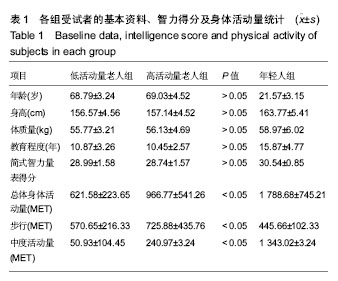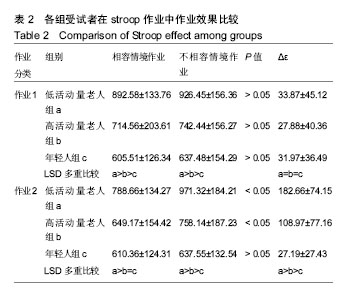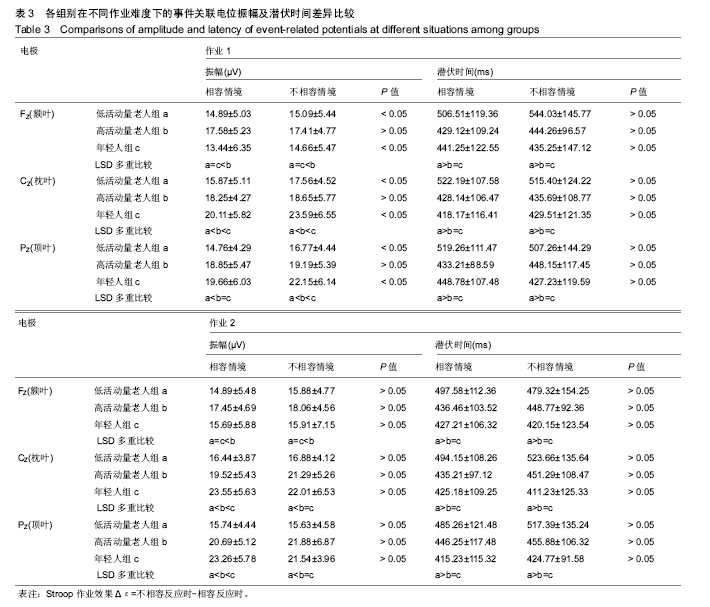中国组织工程研究 ›› 2019, Vol. 23 ›› Issue (11): 1693-1699.doi: 10.3969/j.issn.2095-4344.1137
• 肌肉肌腱韧带组织构建 tissue construction of the muscle, tendon and ligament • 上一篇 下一篇
以事件关联电位评价身体活动量对老年人执行控制功能的影响
黎晋添
- (韶关学院体育学院,广东省韶关市 512026)
Influence of physical activity on executive control function in older adults by event-related potentials
Li Jintian
- (College of Physical Education, Shaoguan University, Shaoguan 512026. Guangdong Province, China)
摘要:
文章快速阅读:
.jpg)
文题释义:
身体活动量:身体活动是指任何经由骨骼肌作用所产生超出静止时能量消耗的任何身体移动,它以代谢当量(metabolic equivalents,METs)作为身体活动强度国际通用计量标准。①1代谢当量代表静态坐着时的能量消耗,相当于每公斤体质量每分钟消耗3.5 mL的氧量;②静态身体活动< 1.5代谢当量,如看电视、阅读、操作计算机等;③1.5代谢当量<轻度身体活动标准< 3代谢当量,如简单打扫等;④3代谢当量<中度身体活动< 6代谢当量,如走等;⑤重度身体活动> 6.0代谢当量,如爬楼梯、慢跑等。
执行控制功能:大脑认知功能为一概括性的名词,系指思考的过程,涵盖了记忆、空间能力、问题表征、决策、注意力等次范畴。在各种不同类型的认知功能中,执行控制功能被认为是一系列与大脑额叶活化有关的高阶认知处理历程,影响到个体整体认知输出的控制历程,如计划、决策、认知灵活性、抑制、对动作的监控等。它可分为意志、计划、目的性行动与有效执行4类,每一类又包含多种不同的认知成分。
.jpg)
文题释义:
身体活动量:身体活动是指任何经由骨骼肌作用所产生超出静止时能量消耗的任何身体移动,它以代谢当量(metabolic equivalents,METs)作为身体活动强度国际通用计量标准。①1代谢当量代表静态坐着时的能量消耗,相当于每公斤体质量每分钟消耗3.5 mL的氧量;②静态身体活动< 1.5代谢当量,如看电视、阅读、操作计算机等;③1.5代谢当量<轻度身体活动标准< 3代谢当量,如简单打扫等;④3代谢当量<中度身体活动< 6代谢当量,如走等;⑤重度身体活动> 6.0代谢当量,如爬楼梯、慢跑等。
执行控制功能:大脑认知功能为一概括性的名词,系指思考的过程,涵盖了记忆、空间能力、问题表征、决策、注意力等次范畴。在各种不同类型的认知功能中,执行控制功能被认为是一系列与大脑额叶活化有关的高阶认知处理历程,影响到个体整体认知输出的控制历程,如计划、决策、认知灵活性、抑制、对动作的监控等。它可分为意志、计划、目的性行动与有效执行4类,每一类又包含多种不同的认知成分。
摘要
背景:身体活动有助于提升老年人认知功能,但其机制并不十分清楚。
目的:探讨身体活动对于老年人认知功能提升的中所产生的大脑补偿机制。
方法:自愿参与受试者45人,分为3组:中低活动量老人组15人;高身体活动量老人组15人;年轻人组15人。运用Stroop两种难度作业在相容及不相容情境下作为测试工具,采用脑波测量(14个电极位置:Fz,F3,F4,Cz,C3,C4,Pz,P3,P4,T3,T4,Oz,O1,O2)并据事件关联电位进行评估。
结果与结论:①相容情境作业下,年轻人与高身体活动量老人的反应时间皆显著快于低身体活动量老人;不相容情境下,年轻人显著快于老年人,而高身体活动量老年人显著快于低身体活动量老年人;②老年人与年轻人在低难度作业下的Stroop效果不存在差异,但在难度较大的作业中,Stroop效果一致表现为低身体活动量老年人显著高于高身体活动量老年人,而高身体活动量老年人显著高于年轻人;③不论作业难度、作业情境及组别差异如何,FZ、CZ与PZ三电极P300潜伏时间一致表现为低身体活动量老年人显著高于高身体活动量老年人及年轻人,而高身体活动量老年人与年轻人的潜伏时间无差异;④FZ、CZ、PZ三电极P300振幅差异明显,其中高身体活动量老年人在FZ电极的P300振幅显著大于低身体活动量老年人及年轻人,而在CZ、PZ两电极处表现为低身体活动量老年人显著小于高身体活动量老年人及年轻人;⑤结果表明,与低身体活动量的老年人相比,高身体活动量老年人进行与干扰控制有关的Stroop作业时拥有更快的反应时间,更高的注意力资源投入及更快的信息处理速度,并且发展出较全面的额叶补偿机制,以维持与年轻人相当的认知处理效率。
中国组织工程研究杂志出版内容重点:组织构建;骨细胞;软骨细胞;细胞培养;成纤维细胞;血管内皮细胞;骨质疏松;组织工程
ORCID: 0000-0002-0128-395X(黎晋添)
背景:身体活动有助于提升老年人认知功能,但其机制并不十分清楚。
目的:探讨身体活动对于老年人认知功能提升的中所产生的大脑补偿机制。
方法:自愿参与受试者45人,分为3组:中低活动量老人组15人;高身体活动量老人组15人;年轻人组15人。运用Stroop两种难度作业在相容及不相容情境下作为测试工具,采用脑波测量(14个电极位置:Fz,F3,F4,Cz,C3,C4,Pz,P3,P4,T3,T4,Oz,O1,O2)并据事件关联电位进行评估。
结果与结论:①相容情境作业下,年轻人与高身体活动量老人的反应时间皆显著快于低身体活动量老人;不相容情境下,年轻人显著快于老年人,而高身体活动量老年人显著快于低身体活动量老年人;②老年人与年轻人在低难度作业下的Stroop效果不存在差异,但在难度较大的作业中,Stroop效果一致表现为低身体活动量老年人显著高于高身体活动量老年人,而高身体活动量老年人显著高于年轻人;③不论作业难度、作业情境及组别差异如何,FZ、CZ与PZ三电极P300潜伏时间一致表现为低身体活动量老年人显著高于高身体活动量老年人及年轻人,而高身体活动量老年人与年轻人的潜伏时间无差异;④FZ、CZ、PZ三电极P300振幅差异明显,其中高身体活动量老年人在FZ电极的P300振幅显著大于低身体活动量老年人及年轻人,而在CZ、PZ两电极处表现为低身体活动量老年人显著小于高身体活动量老年人及年轻人;⑤结果表明,与低身体活动量的老年人相比,高身体活动量老年人进行与干扰控制有关的Stroop作业时拥有更快的反应时间,更高的注意力资源投入及更快的信息处理速度,并且发展出较全面的额叶补偿机制,以维持与年轻人相当的认知处理效率。
中国组织工程研究杂志出版内容重点:组织构建;骨细胞;软骨细胞;细胞培养;成纤维细胞;血管内皮细胞;骨质疏松;组织工程
ORCID: 0000-0002-0128-395X(黎晋添)
中图分类号:



.jpg) #br#
文题释义:#br#
身体活动量:身体活动是指任何经由骨骼肌作用所产生超出静止时能量消耗的任何身体移动,它以代谢当量(metabolic equivalents,METs)作为身体活动强度国际通用计量标准。①1代谢当量代表静态坐着时的能量消耗,相当于每公斤体质量每分钟消耗3.5 mL的氧量;②静态身体活动< 1.5代谢当量,如看电视、阅读、操作计算机等;③1.5代谢当量<轻度身体活动标准< 3代谢当量,如简单打扫等;④3代谢当量<中度身体活动< 6代谢当量,如走等;⑤重度身体活动> 6.0代谢当量,如爬楼梯、慢跑等。#br#
执行控制功能:大脑认知功能为一概括性的名词,系指思考的过程,涵盖了记忆、空间能力、问题表征、决策、注意力等次范畴。在各种不同类型的认知功能中,执行控制功能被认为是一系列与大脑额叶活化有关的高阶认知处理历程,影响到个体整体认知输出的控制历程,如计划、决策、认知灵活性、抑制、对动作的监控等。它可分为意志、计划、目的性行动与有效执行4类,每一类又包含多种不同的认知成分。
#br#
文题释义:#br#
身体活动量:身体活动是指任何经由骨骼肌作用所产生超出静止时能量消耗的任何身体移动,它以代谢当量(metabolic equivalents,METs)作为身体活动强度国际通用计量标准。①1代谢当量代表静态坐着时的能量消耗,相当于每公斤体质量每分钟消耗3.5 mL的氧量;②静态身体活动< 1.5代谢当量,如看电视、阅读、操作计算机等;③1.5代谢当量<轻度身体活动标准< 3代谢当量,如简单打扫等;④3代谢当量<中度身体活动< 6代谢当量,如走等;⑤重度身体活动> 6.0代谢当量,如爬楼梯、慢跑等。#br#
执行控制功能:大脑认知功能为一概括性的名词,系指思考的过程,涵盖了记忆、空间能力、问题表征、决策、注意力等次范畴。在各种不同类型的认知功能中,执行控制功能被认为是一系列与大脑额叶活化有关的高阶认知处理历程,影响到个体整体认知输出的控制历程,如计划、决策、认知灵活性、抑制、对动作的监控等。它可分为意志、计划、目的性行动与有效执行4类,每一类又包含多种不同的认知成分。